There is no new structural narrative in Crypto in 2024, and memes can be popular. A large part of the reason is that there is no market innovation. The narratives, gameplay, and even market players are repeated, and everyone feels aesthetic fatigue.
Recently, many Degen friends have paid attention to Tabi's Tokenomics. There are countless questions in the community every day. I think it is necessary to sort out the complete process. What should we do and why? And what problems have been solved? I hope this article can quickly help you answer your questions.
1. Refer to Curve War / ve model
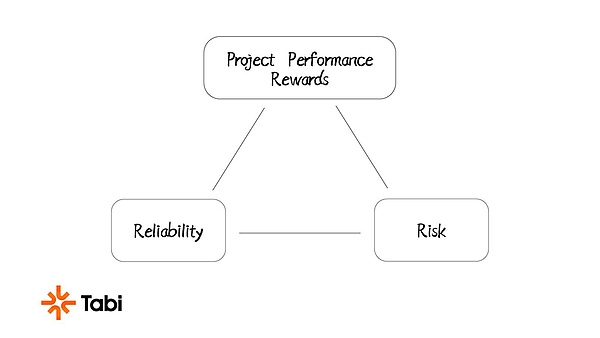
As the largest stablecoin market, Curve has macro-controlled the supply and demand balance of the market by utilizing the bribery mechanism. The project party gives rewards to bribe users, and users need to vote to obtain rewards. At the same time, they need to consider the reliability of the project, the apy of the project reward, and the triangular balance of risks.
Take the field of game distribution as an example (of course, the broader market is still applicable)
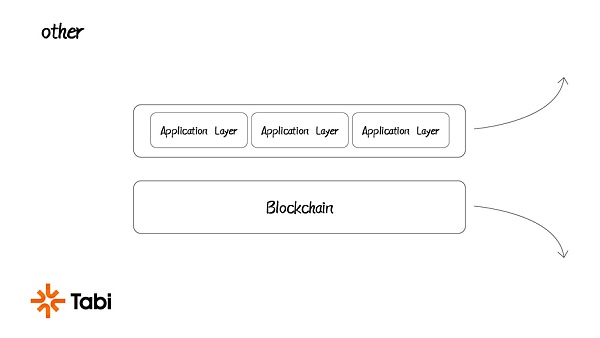
Currently, all chains and application layers are decoupled. The cooperation between games and chains is more of a business-level development. The economic model does not play any role or incentive. The official decides which chain to grant Grant based on its own subjective judgment. There are too many non-project factors here, for example:
a. Relationship level
The founder has a good personal relationship with a BD.
b. Subjective factors
Sam is the BD of a certain chain, but he is more familiar with RPG, but unfortunately, the project he talked about happened to be a simulation business project (I am a senior simulation business enthusiast)
c. Scheduling
There is this saying in any industry, and many similar products have been launched recently.
In short, there is a common feature here, and there is no direct relationship between their decision-making and the community. But it cannot be ignored that it is well known that there are many good works in the game industry every year that are unknown at the beginning, such as "Stardew Valley", "Kenshi" and even the popular "Phantom Beast Palu" some time ago. Countless examples can prove that the community is the first here.
So what will we do?
We have introduced the "Curve War" mechanism to Tabichain for the first time. Before the game goes online, it needs to be publicly introduced and what rewards will be given to the community. Users holding $veTabi choose to vote for projects. Similarly, users need to balance the triangle balance of project quality-reward-risk mentioned above. Which projects rank at the top can get the support of the community, and the emission of $veTabi is the so-called "Grant" to some extent.
But the point is, this is not an official decision, it is a community decision.
What are the benefits of doing this?
a. Chain and application layer coupling
The bottom layer supports the application layer in a true sense, and the application layer feeds back to the bottom layer.
b. Reduce costs and increase efficiency
A chain team has 300 people, 70% of whom are BD teams. Their task is to communicate with different game teams. 2-3 people are responsible for one game team, and they have to hold multiple meetings back and forth. I won’t give a detailed example here. The annual salary of the team may be 15-20 million US dollars, which is not only inefficient but also unable to achieve the goal.
c. Decentralization
The community decides who can get support, and everything is on the chain. The project party has the recognition of the community and does not even need to know the team members.
d. Real introduction of users
Various web3 game task platforms cannot bring real traffic to the project. Most of this traffic stays on social media, which are not real users.
e. High moat brought by super flywheel
Regarding b, I would like to add some thoughts on Pdd and Alibaba. First of all, the conclusion is that Pdd is a dimensionality reduction attack on other e-commerce companies. The so-called dimensionality reduction attack means that I want to destroy you, and your efforts have little effect.
Alibaba's model has 10 million SKUs, managed by 100,000 people. How can these 100,000 people manage 50 million SKUs? The merchants can only be managed by the store clerks, that is, the merchants make a profit from the price difference. Therefore, the core of Alibaba's model is to pursue more categories and sacrifice some efficiency. Of course, this is much more advantageous than traditional retail, so cheapness is the core reason why tb was able to run in the early days, and there is no other way.
So how did Pdd do it?
It does not pursue 10 million skus at the beginning, but only 1,000 skus at the beginning. But it must be extremely cheap, how to be cheap?
Pdd hired 10,000 people to get the ultimate cheapness for these 1,000 skus. Since Pdd has few sku and directly connects with manufacturers, these 10,000 people talk about supply chain all over the world, and directly connect to make single products popular. Because Pdd's strategy is to concentrate all traffic on 1,000 sku, the volume of each sku is quite large, and some people are even willing to lose money to cooperate with Pdd. The specific reasons will not be elaborated.
Back here, so we think we are truly reducing costs and improving efficiency, putting power down, and truly practicing Mao Zedong Thought, "from the people, to the people."
2. Refer to the pricing model of the Dutch auction and POW
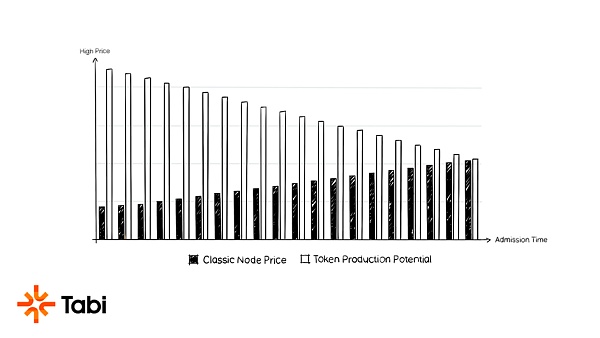
Here we have to mention Gala, it should be the pioneer of node sales. This model is very simple. The cost of early users is low, while the cost of late users gradually increases. The latter users are likely to lose money. It is understood that Gala's Node sale is 500 million US dollars (it has been a long time, and the amount is different). But please remember that this is the model for 2020.
In 2024, a series of Node sales will emerge after Xai/Aethir. We can see that these projects all adopt roughly the same model, using the ideas of 4 years ago. There are still users willing to participate, which can only show that the market is irrational. From the recent market, this model and gameplay have been very weak. I don’t think the market has no money, but the market is tired of similar themes.
So how does Tabi do it?
Here, I refer to the pricing model of the Dutch auction and POW. I have been in contact with BTC since 2013 and am also a mining participant. Every time a new generation of mining machines appears, the computing power of the new models increases, resulting in the new mining machines crushing the computing power of the old mining machines. If you no longer buy new models to increase the computing power, you will naturally be eliminated. Therefore, whenever a new mining machine appears, the computing power on the market is in short supply, so above the official guide price, people are willing to pay a higher price to buy, because this can get more computing power dividends and mine more BTC. It is obvious that the market determines the supply and demand relationship, not the subjective wishes of people.
Therefore, I refer to the experience of the Pow mining machine. I think it is more in line with market economics, rather than users who buy early making a huge profit and users who buy late losing a huge loss. Today, users have been educated by the market for many rounds. This model is no longer applicable to the market, and I think this system itself is selfish, because it obviously takes advantage of people's Fomo psychology, and nothing else helps.
The core logic of this model:
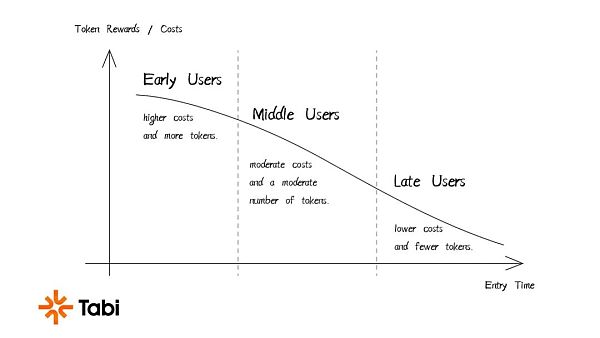
Early users = pay higher costs = get more tokens
Mid-term users = pay medium costs = get medium tokens
Late users = pay cheap costs = get a small number of tokens
If you study it carefully, you will find that the balance and game under this system are everywhere, and no one is absolutely at a disadvantage.
3. Original NODE hierarchy
Gala, Xai and other nodes only have price differences, but no difference in computing power. This is very unreasonable. Remember that users must be getting smarter and smarter. Users are not fools. If you still treat users as fools today, then the fool must be you.
Why introduce levels?
Under models such as Gala and Xai, there will definitely be an unsolvable problem, that is, the cost of early users is low and the advantages are huge. In this case, users will only mine, sell and withdraw until no one has the motivation to buy tokens. Recently, we can see a series of node projects released. No one has really thought about this problem carefully. Who will buy the nodes later and why can they be bought later?
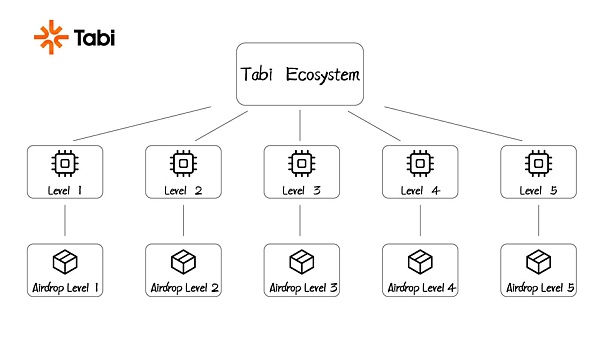
Tabi node is sold at 5 levels. Each level of mining machine has certain advantages over the previous mining machine once it is launched, and our new projects in the Tabi ecosystem can provide airdrops to different user levels according to their own needs.
But this is not the point. The most important thing is that Tabi node can be upgraded!
As mentioned earlier, users can get veTabi by participating in Tabi node and vote to get rewards, but this does not solve the core problem. Why should users participate in ecological projects?
Because participating in ecological projects can improve the node level, this truly introduces users into ecological projects, thereby truly combining the chain and application layer ecology.
Take the game as an example, the user process here is:
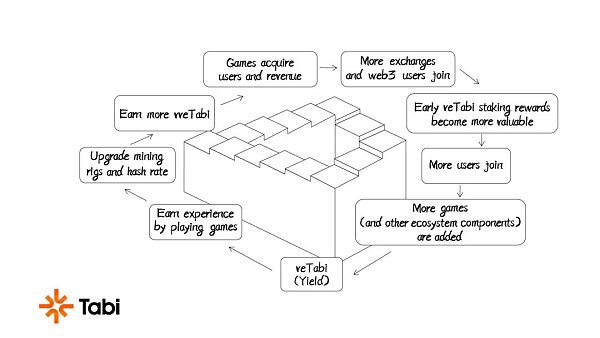
In order to obtain more veTabi (income) - play games to gain experience - upgrade the level and computing power of mining machines - get more veTabi - games to obtain users and income - exchanges and more web3 users join - veTabi's early voting reward assets become more valuable - more users join - there are more games (and other ecosystems) to form an absolute advantage. This flywheel effect enhances Tabi's influence on game distribution.
4. Refer to Canto
The current situation is that most Layer1s exploit all application layers downwards. It should be noted that all Layer1 revenues come from users in the ecosystem. User interactions are actually interactions with the application layer, not the chain itself.
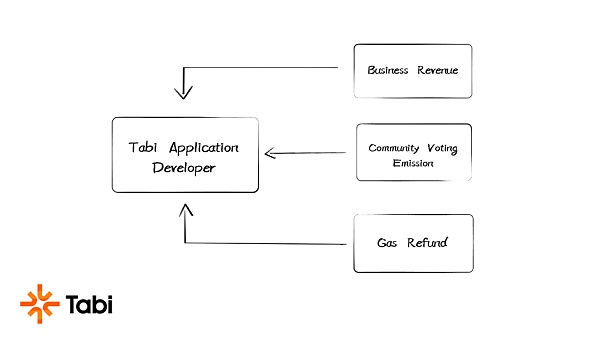
Tabi refers to Canto to share gas revenue with application layer developers, which means that the revenue sources for developing applications in Tabi are richer, including business revenue + community voting emissions + Gas returns.
5. Symbiotic relationship
80% of the revenue of most games comes from 20% of the players. These users are the whales that any game wants. As mentioned earlier, Tabi node is an advanced level model, which is equivalent to 200,000 node holders.
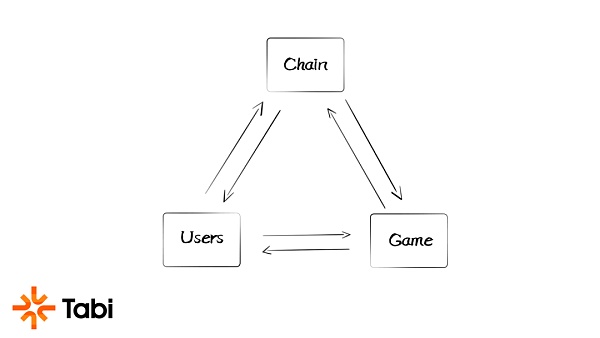
Tabi encourages game developers to give various rewards to node holders of different levels according to their project types. This is equivalent to the early cold start asset holders being the whale community, so that the binding relationship between the community and developers is sustainable.
Not only that, based on this set of Tokenomics, we will guide ecological developers in the future, and protocols similar to Convex will gradually appear, even including Mundus, which we are incubating at the same time. It will serve as an important infrastructure on Tabichain, similar to Roblox, which acts like an intermediate layer to help users quickly build their own small games, a UGC developer community.
I have been thinking about what the core moat of L1 is? Is it faster? More decentralized? Cheaper?
There are a thousand Hamlets in the eyes of a thousand people, and there is no absolute right answer. We provide more business possibilities from the perspective of developer commercialization. At the same time, the characteristics of PolyVM (link) are more friendly to web2 developers and reduce the entry cost of developers.
Please allow me to subjectively think that we put developers at the forefront of priority. We have fully thought about business, from revenue structure to user path design, and we have made full preparations in technology to meet the future mass adoption.
 Hui Xin
Hui Xin
 Hui Xin
Hui Xin Jasper
Jasper Joy
Joy Aaron
Aaron Jixu
Jixu Jixu
Jixu Davin
Davin Hui Xin
Hui Xin Aaron
Aaron Aaron
Aaron